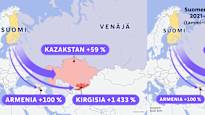Economic sanctions and the voluntary withdrawal of companies have collapsed Finnish exports to Russia after the start of the war in Ukraine.
At the same time, Finland’s exports to Central Asia and the Caucasus have grown enormously.
There are legal and illegal reasons for that, says the Director General of Customs Sami Rakshit and Russia researcher, professor at Turku University of Economics Kari Liuhto.
The legal reason is that some of the current Central Asian exports used to go to warehouses in Russia, from which local companies then exported goods to Central Asian countries. Now Finnish companies sell goods directly to, for example, Kazakhstan and Kyrgyzstan.
– The illegal side is that EU economic sanctions are circumvented through Central Asia, especially Kazakhstan, and the goods finally end up in Russia, says Liuhto.
Rakshit estimates that some of the goods end up in Russia in such a way that it does not reach the company exporting the goods from Finland at all. In part, it is a matter of fully conscious action.
– The demand is strong and the attractiveness is great, because the purchase prices may be significantly higher than when selling to the so-called normal market.
Huge growth rates
Customs’ goods export statistics reveal huge growth figures for Finland’s exports to Central Asia. compared the statistics from the first half of the current year, i.e. January–June, to the time before the war, i.e. January–June 2021.
For example, Kyrgyzstan’s exports have grown by 1,433 percent during that time, i.e. exports have increased approximately 15-fold.
Last year, exports rose significantly more. In the whole year 2021, Finland’s exports to Kyrgyzstan were more than 3 million euros, and in 2023 the exports had already risen to more than 112 million. So the increase was about 35 times.
This year, exports to Central Asia have collapsed when Finland’s eastern border has been closed. The blockade also cut off tire traffic to Central Asia, as the route there has mainly passed through Russia. Exports are still significantly higher than before the war.
Kyrgyzstan’s huge growth figures are partly explained by the fact that before the war Finnish exports to the country were non-existent.
For example, exports to Kazakhstan were more plentiful even before the war. Therefore, the growth rate is lower. In the first half of this year, about 57 million worth of goods were exported from Finland to Kazakhstan. It was about 60 percent more than before the war in January–June 2021.
According to Tullin’s Rakshit and Professor Liuhto, it is impossible to estimate how much of Central Asia’s exports actually go to Russia.
However, it is known that the growth of Finland’s exports to Central Asia comes mostly from goods that are on Russia’s embargo list.
There is also a lot of stuff needed by the Russian war machine. Kari Liuhto gives examples of earthmoving machines and truck tractors.
– Before the start of the war of aggression, a few trucks went to Central Asia. Then in 2023, a couple of hundred of them suddenly went to Kazakhstan and Kyrgyzstan.
Why Central Asia and the Caucasus?
All EU exports to Central Asia and the Caucasus started to increase shortly after Russia invaded Ukraine.
In terms of evading sanctions, the countries of the region are favorable routes for Russia. Many of the countries in the region belong together with Russia to the Eurasian Economic Union, within which goods move freely. There are also many Russian speakers in the area.
Many companies include a clause in their export contracts that prohibits re-export to Russia. In practice, however, control is difficult.
Exports from Finland to Central Asia mainly go through Russia. If it is about evading sanctions, and the goods are actually going to Russia, they will hardly ever get there.
– If the intention is to commit fraud, then why on earth transport goods all the way to Kazakhstan? It will probably stay in Russia along the way, says Kari Liuhto.
The development of exports between the countries has varied during all the war years. Customs’ Sami Rakshit considers the explanation to be that the most favorable detour for sanctions has gradually changed.
– The toss-up is so big that to me those numbers tell me that the logistical routes related to evading the sanctions have varied.
The Western countries, led by the EU, have also tried to influence the countries in the region so that they would block the sanctions’ bypasses. Especially Kazakhstan, which is the region’s largest trade partner for the EU, has come under pressure from the EU.
Sanctions evaders are one step ahead
In the first half of this year, exports to Central Asia and the Caucasus fell by about half compared to last year. The decline started as soon as the eastern border, i.e. the road route to the area, was closed.
The exports of other EU countries have hardly decreased. Substitute routes for Western goods are especially in the Baltics, where exports to Central Asia are also enormously high.
According to Customs’ Sami Rakshit, this illustrates that some of Finland’s exports have actually come from other EU countries. The goods have first been brought to Finland, especially from Central Europe, and the goods for export to Central Asia have only been registered in Finland.
The procedure complicates the monitoring of sanctions.
Professor Kari Liuhto states that Russia has constantly found new routes to import embargoed Western goods. In addition to the companies acting as middlemen, the Russian intelligence authorities are also involved in the smuggling of embargoed goods. Liuhto says that Western authorities are constantly one step behind.
– When a route has been detected in the West, the trocars and the Russian intelligence service have always found a new route.
MOT revealed how Finnish companies have exported goods useful for the military machine to Russia for millions
